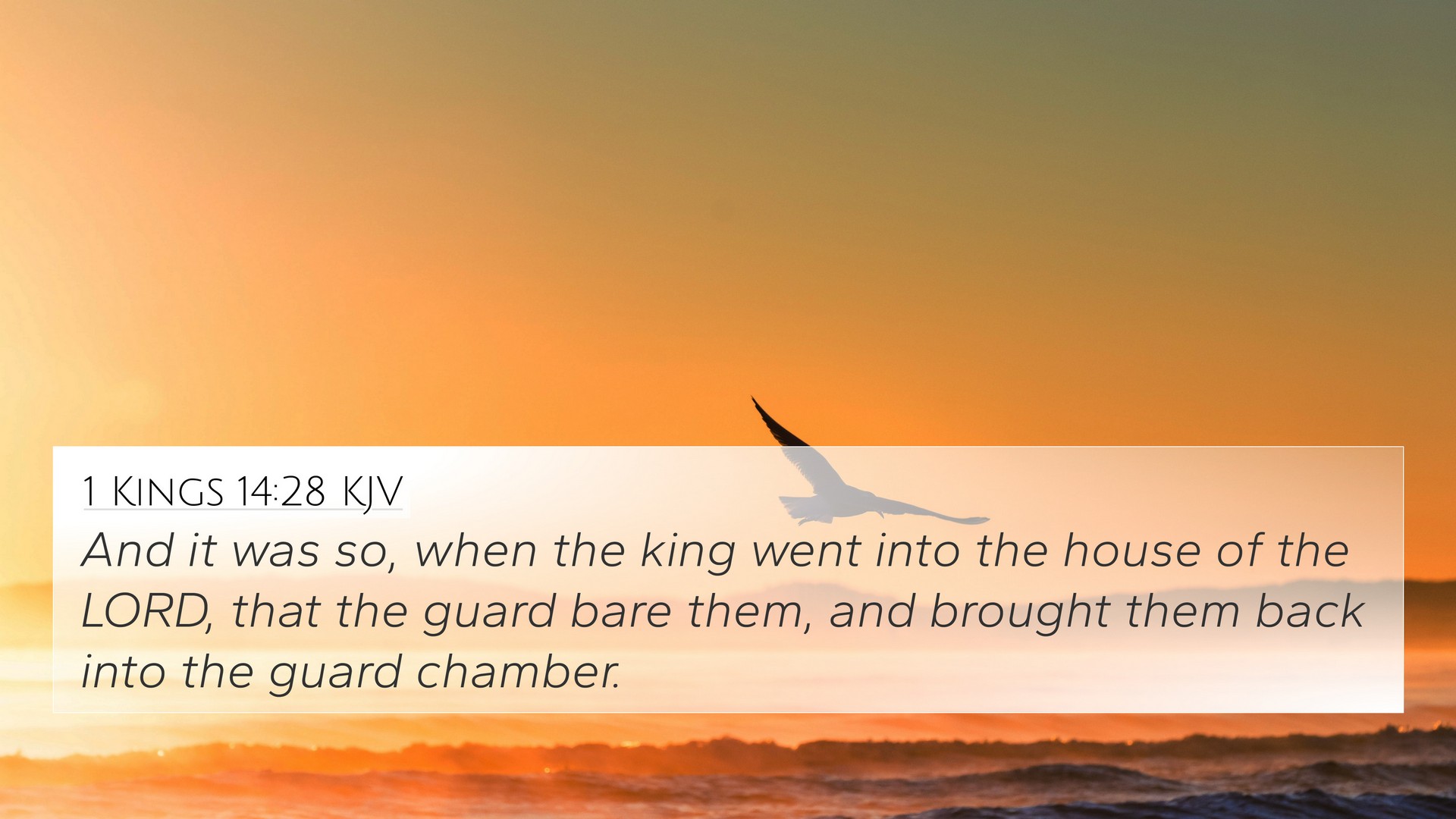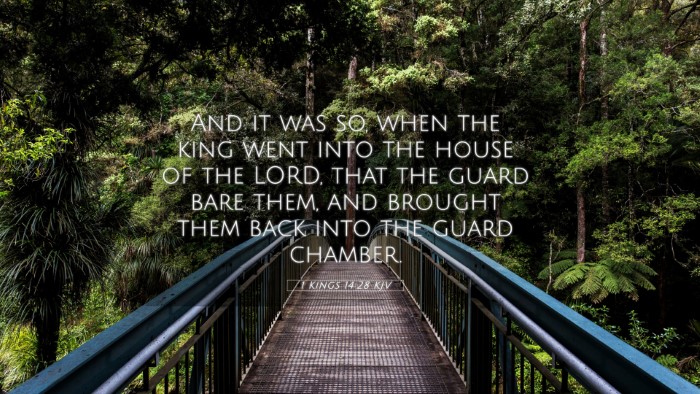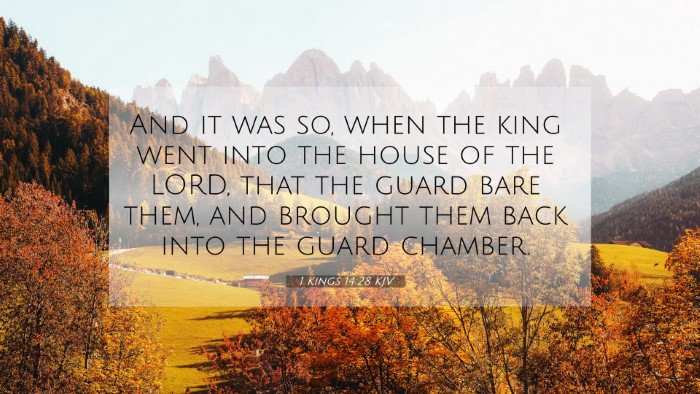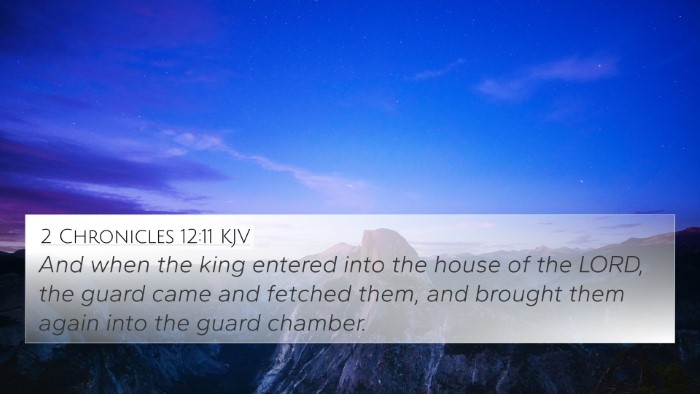Meaning of 1 Kings 14:28
Bible Verse: 1 Kings 14:28 - "And it was so, when the king went into the house of the LORD, that the guard bare them, and brought them into the chamber of the guard."
Summary of Insights
The verse depicts the actions of King Rehoboam as he undertakes the sacred duty of presenting offerings before God in the temple. This moment is significant for understanding the relationship between the monarchy and the divine directives of worship within the Israelite community. The act of bringing offerings was rooted in the acknowledgment of God's sovereignty and a necessary component of maintaining spiritual favor.
Commentary Insights
-
Matthew Henry:
Henry emphasizes the importance of the temple as a holy place where the king offers sacrifices. This action indicates the king’s recognition of God's authority over his reign. Furthermore, Henry points out that the guards’ involvement symbolizes the security surrounding sacred practices, assuring that reverence is maintained during worship.
-
Albert Barnes:
Barnes provides an analysis of the significance of offerings as a reflection of commitment to God. He highlights that the king is fulfilling his religious duties and upholding the tradition established in Israel, which was essential for God’s blessing upon the land. This verse serves as an illustration of how civil leaders were expected to align their governance with spiritual obligations.
-
Adam Clarke:
Clarke contextualizes the role of the guards carrying the offerings as a representation of the community's involvement in worship. He discusses the ritualistic aspects associated with the offerings and notes that this public display reinforces the king's role in leading the nation towards God. Clarke’s insights remind readers about the importance of collective worship alongside individual responsibilities.
Cross-References
1 Kings 14:28 ties into several other scriptural passages. Here are a few notable cross-references:
- Exodus 30:18-21: Discusses the importance of the brazen laver in the tabernacle for purification, reflecting the need for holiness in approaching God.
- 2 Chronicles 7:14: Emphasizes the concept of humility and prayer in seeking God's favor, resonating with the themes of worship depicted in 1 Kings 14:28.
- Psalms 118:27: Talks about God as the source of blessings during sacrificial offerings, indicating the continuity of temple worship.
- Isaiah 1:13-14: Warns against empty rituals, contrasting the sincere offerings expected from the people of God.
- Hebrews 13:15: Connects to the idea of offering sacrifices of praise, aligning with the intentions behind 1 Kings 14:28.
- 1 Chronicles 29:20: Illustrates the royal family’s participation in communal worship, underlining the expectations placed upon leaders.
- Luke 11:42: Offers insight into the critique of religious practices, emphasizing inner spirituality over mere outward actions, a theme relevant to the sacrifices presented in the temple.
Thematic Connections
This verse encapsulates several thematic elements which are worth exploring in deeper study:
- Worship and Sovereignty: The connection between religious observance and civil authority, seen clearly in the responsibilities placed upon the king.
- The Role of Leaders in Faith: The expectation for spiritual leadership among civil authorities, as illustrated by King Rehoboam's actions.
- Community and Collective Worship: The involvement of guards signifies a communal approach to worship, representing the nation’s relationship with God.
Inter-Biblical Dialogue
The connections between this verse in 1 Kings and other scriptural texts reveal a broader narrative of religious duty and governance in the biblical context. Understanding these relationships enhances the reader’s insight into how worship was interwoven with national identity in both the Old and New Testament.
Tools for Bible Cross-Referencing: To further explore these connections, consider using resources such as Bible concordances or specialized cross-reference guides. These tools will aid in identifying and understanding the intricate relationships between various scripture passages.
Conclusion: 1 Kings 14:28 serves not only as a historical record of King Rehoboam's actions but also as a significant reference point for understanding the role of worship in ancient Israel. By exploring this verse through cross-references and the insights of biblical commentators, one can appreciate the depth of meaning inherent in the sacred texts.



